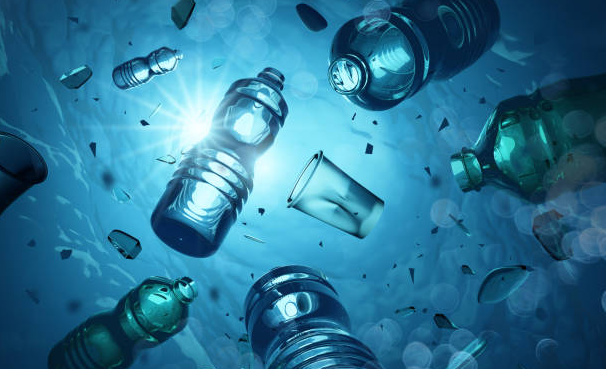SHUBHAM SHARMA & JYOTI YADAV
Plastics are very essential products; in fact, you see them virtually everywhere. Almost everything we interact we daily have components of plastics in it. Of course, there are different types of plastics, and some materials you own are made from plastic, and you don’t even know it. Well, just as plastics are essential production materials, the manufacturing process leaves a detrimental effect on our environment. You can even say that it’s one of the most dangerous man-made materials. Not only is its production process harmful to the environment, but its decomposition process is also.
Recently a new study has found that the global oceans are polluted by nearly 170 trillion pieces of plastic that weigh approximately 2 million tonnes. The estimates are made by analyzing the trends of ocean plastic from 1979 to 2019. Plastics entering the world’s oceans have surged by an “unprecedented” amount since 2005 and could nearly triple by 2040 if no further action is taken. The environment is where we all meet, where we all have a shared interest, and it is the one thing we all have in common, as Lady Bird Johnson rightly stated. Humans have always looked on nature and the resources it provides to meet all of their needs, from food to shelter to clothing. As our population and our demands continue to rise, so does our dependence on nature.
We have not been kind towards our nature as we have always kept our interests forward. We frequently overlook the fact that our ecosystems support countless types of flora and fauna in addition to us humans. Because of how we treat the environment, biological variety is out of balance, which has an effect on the health of nature as a whole. Indeed, we have continuously put the ecology under stress. It began with the excessive tree cutting and sewage thrown into the ocean. Our environmental concerns have grown in number, significance, and complexity over time.
In India, the GDP is anticipated to increase by 10.5% during the fiscal year 2022–2023. It has one of the world’s fastest developing economies. Manufacturing, exports, healthcare, and ammunition are just a few of the industries that have seen significant advancements. While progress is good for society’s socioeconomic development, the environment suffers greatly as a result. When it comes to pollution, contemporary India faces a plethora of difficulties. The most serious of several problems is contamination of the air and water. Eighty percent of all surface water has been tainted. Pesticide use has also resulted in soil contamination and underground stream contamination. Cities like Mumbai and Delhi have some of the worst air quality indices in the entire world. Although there are many reasons why things are the way they are, plastic stands out as the main culprit.
Plastic, one of the most useful technologies ever, was created in 1907 by Belgian scientist Leo Baekeland. It is affordable and highly versatile. It is utilized everywhere, from autos to space technology. Once it has served its purpose, we dispose of it as we do with everything else. It is no longer a concern for us once it is in the trash can and outside the house. We have not been kind towards Mother Nature as we have always kept our interests forward.
A plastic bag thrown by our grandmother could still be buried deep down in a landfill or it may be floating in a river. Although it is not the only cause of pollution, plastic is unquestionably the largest. Plastic pollution is the term used to describe the buildup of plastic waste and its damaging effects on ecosystems. With India possibly being the worst sufferer of plastic pollution, the devastation done cannot be adequately expressed in words.
The Impact of Plastic Pollution
India alone generates more than 30 lakh tonnes of plastic waste. This figure is of the past year and is expected to grow by 20% for the every year. In the year 2015, this figure was at 15 lakh tonnes. Our reliance on plastic has increased but our capacity to get rid of it has stayed the same or even reduced. Recycling is not a common practice in India and all the waste is dumped in the ocean or in landfills. Plastic waste comes from all spheres including manufacturing and health care. Right from the start, plastic is detrimental to our surroundings. The chemicals used in the manufacturing of plastic are derived from non-renewable sources such as coal and petrol. It releases toxins that stay in the environment for years and years to come. It is also considered to be a primary contributor to the greenhouse effect.
Polyethylene is the most commonly used and produced form of plastic. Once it is disposed off, it releases a lot of methane which is considered more toxic than carbon dioxide. The release of chemicals and the greenhouse effect leads to an increase in the number of dengue and malaria cases and causes various respiratory diseases. The global temperature keeps rising and a lot of the blame has to be put on plastic. If disposed of without any treatment, the toxins are absorbed by the soil and the underwater supply is also contaminated. The species of plants and animals that rely on this water also suffer from the toxins they consume.
When plastic is dumped in the water, the nano-plastic molecules affect the behaviour of fishes as it seeps through the brain-blood barrier. Plankton and aquatic plants cannot survive in the presence of plastic. Humans are not immune to the harmful effects of plastic. If exposed to the chemicals omitted from plastic there is a high risk of cancer, congenital defects, and even reproductive problems.
(To be continued…)
(Authors are Advocates at Delhi High Court and can be reached at [email protected])








